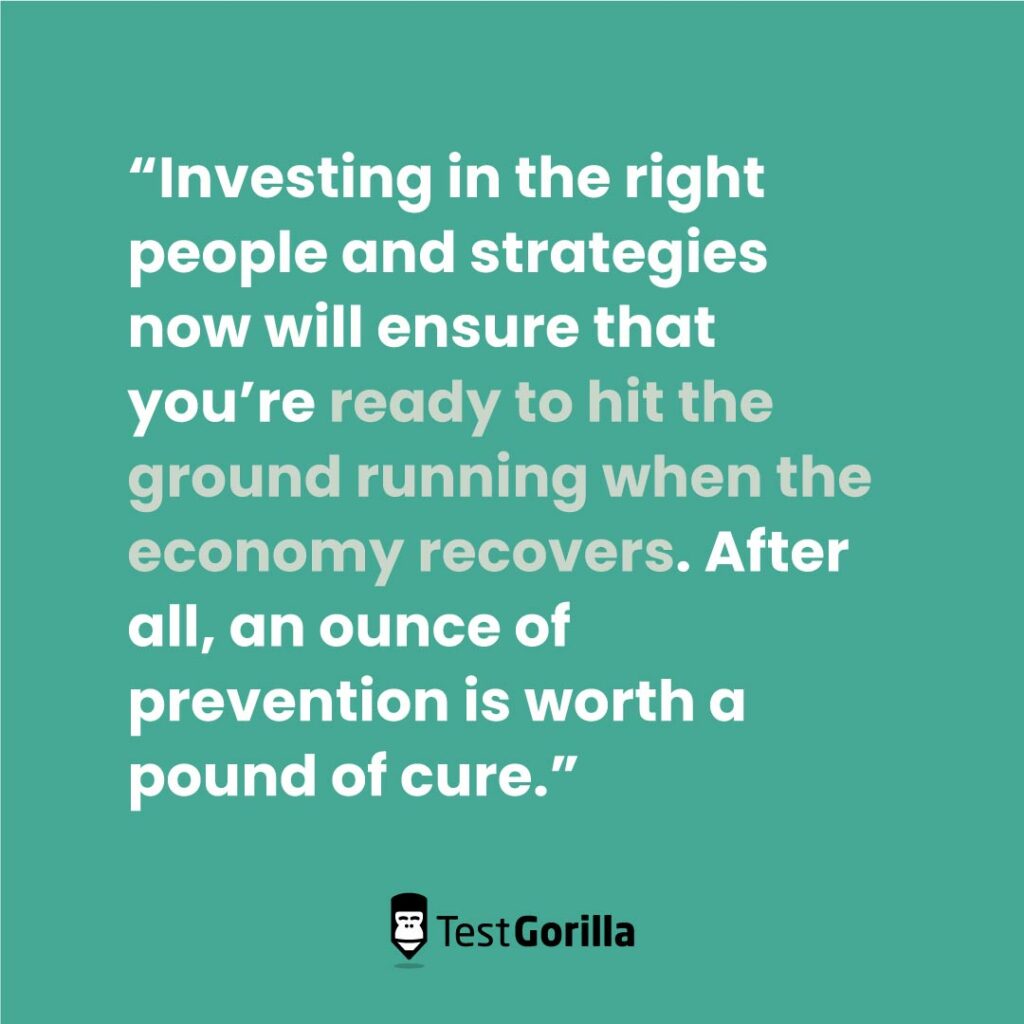Look. Anyone who tells you they know where the economy is headed in the next year is lying. The economic signals are all over the map. Some industries continue to face extreme worker shortages, while others are laying off talent by the hundreds of thousands.⁽¹⁾⁽²⁾ Travel and transportation are rallying while massive retailers are pulling on the reins.⁽³⁾⁽⁴⁾ The Fed remains cagey about how much it’s willing to ratchet up interest rates to fight inflation.⁽⁵⁾
In the face of so much economic uncertainty, many employers choose to slash the fattest part of their budgets – their people. Layoffs, hiring freezes, and furloughs can stem the bleeding of short-term revenue losses, but they don’t ease the long-term pain. So many of these strategies threaten to hamstring a business by damaging morale, throttling progress on initiatives, and hemorrhaging money if the cuts turn out to be too deep and a company has to rehire immediately.
There’s a better way for hiring managers to navigate the rough waters ahead. It’s better for your budget, better for your workforce, and better for your prospects – in both the short term and long term.
Table of contents
- Learn from the economic turmoil of the past
- Plan now and hire with the end goal in mind
- Align budgets to headcount
- Identify the right roles, and fill them with A-players
- Build a talent pipeline
- Avoid overhiring by using technology
- Keep learning and career development programs alive
- Take advantage of new ways of working
- To the flexible and adaptable go the spoils
- An ounce of hiring strategy now is worth a pound of growth later
- Sources
Learn from the economic turmoil of the past
History doesn’t repeat itself, but it does rhyme.
This is not the first time the US, or the world, faced a dip in the economy. This century alone brought us the dot-com bust, the Great Recession, a scary slump in energy and manufacturing, and the pandemic.
Each of these events left deep scars on different industries. Companies that survived did so by recruiting transferable skills from other industries, keeping in touch with their contacts, and taking the opportunity to fix what was broken about their hiring strategies.
The best way to stave off serious impacts on your business this time around is to focus on sustainability and efficiency at each step of your hiring plan.
Many companies add headcount to solve for volume or complexity instead of leaning into focusing on efficient, scalable, and sustainable business practices.
In other words, look for ways to do more with fewer people. When the right talent is in place and you have a good plan for developing them, you maximize output while managing costs. Companies that take this approach can weather recessions better than those that haven’t planned.
Plan now and hire with the end goal in mind
The single largest mistake companies make is hiring without a headcount plan. The planning part is something that too often gets overlooked in the giddy days of rapid growth.
Tech popularized this approach by “blitzscaling” to overwhelm the competition in an attempt to dominate winner-take-all markets. Blitzscaling is a great way to get to the “podium” first, but it’s not necessarily the best way to stay there.
In a recession, having an agile and efficient hiring process is critical. Companies should plan and think about their end goal: what type of talent they need and how many people they need to bring to reach that goal.
Planning allows you to make strategic decisions about who, where, and when to hire – as well as how much you’re willing to invest in each new hire. This can help ensure that your team remains a healthy mix of experienced veterans and fresh talent while avoiding any unnecessary costs.
The best insights on HR and recruitment, delivered to your inbox.
Biweekly updates. No spam. Unsubscribe any time.
Align budgets to headcount
How people calculate their headcount needs is often based on a traditional method or on making up the numbers based on anecdotes or industry truisms. Instead, companies must link that headcount plan back to the budget.
Taking the time to carefully review overhead costs like payroll and benefits can help you identify areas where you can reduce spending without sacrificing quality talent. It also helps you calculate clearly why, when, and who they need to hire – as well as how much you’re willing to invest in each new hire.
This is a tricky one, but it’s essential for ensuring you have the right mix of experienced veterans and fresh talent with a diversity of skills.
Identify the right roles, and fill them with A-players
In a recession, you don’t want to cut the wrong people. Take the time to determine which positions are critical for your company’s profitability and sustainability.
Once you’ve identified the essential roles, focus on filling them with experienced professionals who will excel in their positions. Often, leadership teams don’t focus on the critical, highly skilled roles early enough.
Even though these positions are more expensive, having those quality roles in place will have a much bigger impact on the team, the company, and the bottom line than hiring for quantity.
In a recession, A-players are hard to come by – but they’re worth their weight in gold. Great talent can mean the difference between success and failure during an economic downturn.
A-players can help you identify better and more efficient processes, take initiative to improve your bottom line, and foster an environment of collaboration. They don’t just do their jobs; they develop the talent around them, too.
Build a talent pipeline
When the economy recovers, you don’t want to scramble to fill open positions. Invest in building a talent pipeline that can quickly scale when needed. This can include creating an alumni network or recruiting pool to tap into existing contacts or engage new candidates.
It’s important to actively keep in touch with former employees and remain connected to potential hires.
These connections can help you quickly identify great talent when the economy recovers and you’re ready to hire again.
Avoid overhiring by using technology
It’s tempting for employers to hire more people than necessary to have enough manpower when the economy turns around. But that’s a bad decision and can lead to an unsustainable overhead that will be difficult to pay for in the future.
A thoughtful approach to integrating technology into your workflow makes it easier to scale without increasing headcount.
Spend time with your team. Figure out what is sucking up all their time. Is it a tool that isn’t scaling? Talk with the vendor to see if there’s a better way to integrate your processes and automate some of your team’s workflow. If not, replace it with something that scales with your company.
Other times, you might discover it is a customer support challenge. Try to stem the tide of questions and concerns with better documentation like product FAQs and technical papers, or incorporate a chatbot into your customer support workflow.
Keep learning and career development programs alive
Focusing on professional development helps ensure current employees stay engaged and productive during a downturn. It also shows potential candidates that your company is committed to its people, even when times are tough.
Implementing ongoing learning and career development programs can help you attract top talent in a competitive market while also allowing current employees to stay up to date on the latest industry trends and technological advancements.
These initiatives can include online courses or seminars, access to self-study materials, mentorship programs, and job rotation opportunities.
Take advantage of new ways of working
When the pandemic hit, many businesses discovered they could work remotely just as effectively as in an office setting. This shift resulted in cost savings for companies while also providing employees with more flexibility. This can be a great opportunity to save money while making sure your talent remains engaged and productive.
In a recession, it’s important to recognize the value of your team and make sure they feel appreciated. A flexible environment can help you achieve that while also helping you manage costs.
To the flexible and adaptable go the spoils
When financial headwinds blasted Zapier, leadership responded with temporary assignments to different roles and departments, not layoffs. This move meant Zapier kept its people employed by putting its workers’ skills and competencies to effective use in other critical areas of the company.
It’s not Zapier’s first experience with a faltering economy; the company knew that, eventually, that curve would rise again. Where others had to lay off, then rehire hundreds of people at great cost, Zapier maintained continuity.
That extra effort went a long way toward preserving workforce morale. And, since Zapier kept its top performers on board, it meant the company was ready to outflank the competition when the economy heated back up.
This will take major flexibility and adaptability from both the company and the employees, but it’s worth the change in mindset. The trust and belonging this approach creates within your workforce leads to an environment where everyone wants to stay and succeed with the company.
To pull this off, though, hiring managers can’t focus narrowly on resumes when they hire. Many organizations don’t realize the importance of skills and competencies rather than experience and job titles when it comes to hiring talent. This makes it harder for companies to pivot without wasting lots of time and money training employees or rehiring for new roles.
An ounce of hiring strategy now is worth a pound of growth later
Recession-proofing your talent strategy isn’t easy, but it’s worth the effort. For companies that shift their mindset from resume-based hiring to skills-based hiring, there is no going back. This is the future of hiring.
It’s a sustainable, efficient way to manage your company’s talent strategy, so you can protect your bottom line while still attracting and retaining top talent during tough economic times.
Investing in the right people and strategies now will ensure that you’re ready to hit the ground running when the economy recovers. After all, an ounce of prevention is worth a pound of cure.
Sources
Ferguson, Stephanie “Understanding America’s Labour Shortage: The Most Impacted Industries,” US Chamber of Commerce (March 2023) https://www.uschamber.com/workforce/understanding-americas-labor-shortage-the-most-impacted-industries
Tech Layoffs tracker https://layoffs.fyi/
US Travel Association “The Latest Travel Data” (March 2023) https://www.ustravel.org/research/monthly-travel-data-report
Carufel, Richard “With economy unstable, retail marketers prioritize retention, CX and pulling back on social in 2023,” Agility PR (Feb 2023) https://www.agilitypr.com/pr-news/public-relations/with-economy-unstable-retail-marketers-prioritize-retention-cx-and-pulling-back-on-social-in-2023/
Winters, Mike “The Fed is expected to raise interest rates, despite recent banking turmoil: ‘This will be a game-time decision’,” CNBC (March 2023) “https://www.cnbc.com/2023/03/22/the-fed-is-expected-to-raise-interest-rates-despite-banking-turmoil.html
You've scrolled this far
Why not try TestGorilla for free, and see what happens when you put skills first.





















